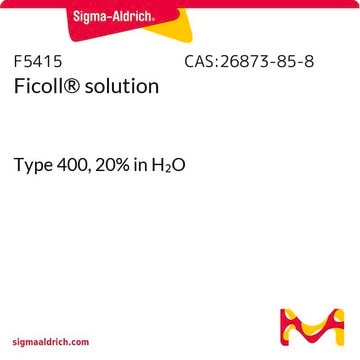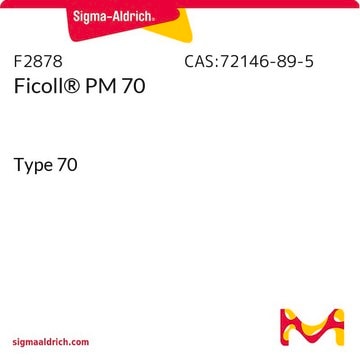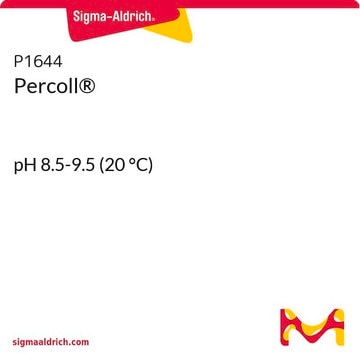Products may be shipped at a different temperature than the recommended long-term storage temperature. If the product quality is sensitive to short-term exposure to conditions other than the recommended long-term storage, it will be shipped on wet or dry-ice. If the product quality is NOT affected by short-term exposure to conditions other than the recommended long-term storage, it will be shipped at ambient temperature. As shipping routes are configured for minimum transit times, shipping at ambient temperature helps control shipping costs for our customers. For more information, please refer to the Storage and Transport Conditions document: https://www.sigmaaldrich.com/deepweb/assets/sigmaaldrich/marketing/global/documents/316/622/storage-transport-conditions-mk.pdf
F4375
Ficoll® PM 400
Type 400
Synonym(s):
Polysucrose 400
About This Item
Recommended Products
type
Type 400
Quality Level
form
powder
spray-dried
optical activity
[α]20/D 56.5°, c = 1% (w/v) in water
color
white to off-white
solubility
H2O: 100 mg/mL, clear to slightly hazy, colorless to faintly yellow
storage temp.
room temp
Looking for similar products? Visit Product Comparison Guide
General description
Application
Features and Benefits
Other Notes
Preparation Note
Sigma tests the solubility of Ficoll 400 at 1 g in 10 ml of deionized water yielding a clear to slightly hazy, colorless to faint yellow solution. Ficoll is stable in alkaline and neutral solutions. At pH values below 3, it is rapidly hydrolyzed, particularly at elevated temperatures. Ficoll can be sterilized by autoclaving at a neutral pH, at 110oC for 30 minutes. Strong oxidizing and reducing agents are to be avoided.
Legal Information
Storage Class Code
11 - Combustible Solids
WGK
WGK 3
Flash Point(F)
Not applicable
Flash Point(C)
Not applicable
Personal Protective Equipment
Choose from one of the most recent versions:
Certificates of Analysis (COA)
Don't see the Right Version?
If you require a particular version, you can look up a specific certificate by the Lot or Batch number.
Already Own This Product?
Find documentation for the products that you have recently purchased in the Document Library.
Customers Also Viewed
-
How is shipping temperature determined? And how is it related to the product storage temperature?
1 answer-
Helpful?
-
-
How can I determine the shelf life / expiration / retest date of this product?
1 answer-
If this product has an expiration or retest date, it will be shown on the Certificate of Analysis (COA, CofA). If there is no retest or expiration date listed on the product's COA, we do not have suitable stability data to determine a shelf life. For these products, the only date on the COA will be the release date; a retest, expiration, or use-by-date will not be displayed.
For all products, we recommend handling per defined conditions as printed in our product literature and website product descriptions. We recommend that products should be routinely inspected by customers to ensure they perform as expected.
For products without retest or expiration dates, our standard warranty of 1 year from the date of shipment is applicable.
For more information, please refer to the Product Dating Information document: https://www.sigmaaldrich.com/deepweb/assets/sigmaaldrich/marketing/global/documents/449/386/product-dating-information-mk.pdfHelpful?
-
Active Filters
Our team of scientists has experience in all areas of research including Life Science, Material Science, Chemical Synthesis, Chromatography, Analytical and many others.
Contact Technical Service














